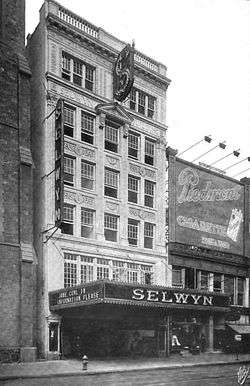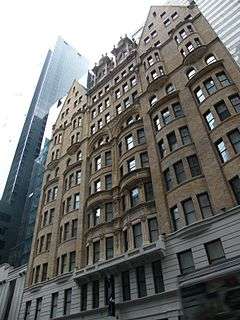George Keister

George Keister was an American architect. His work includes the Hotel Gerard (1893), Astor Theatre (1906),[1] Belasco Theatre (1907), the Apollo Theater (1914), the Bronx Opera House (1913), the Selwyn Theatre (1918), now known as American Airlines Theatre, and the First Baptist Church in the City of New York. He also designed Woodbridge Hall at 431 Riverside Drive (1901), which faced demolition in 1996, and the Sigma Chi Fraternity at 565 W. 113th St. (1903). Preservationist Carolyn Kent helped save some of his work.
History
Keister was a skilled but little known architect who was active in New York City from the mid-1880s into the third decade of the twentieth century. He had a brief partnership with Frank E. Wallis (1887–88) and in the 1890s, served as secretary of the Architectural League. Although barely a score of his buildings have been identified, the collection indicates a gifted and innovative architect with facile design ability in a variety of styles. Prior to David Belasco's Stuyvesant, he had designed three New York theaters: in 1905, the Colonial (Hampton's; at 1887 Broadway) and Loew's Yorkville Theater (157 East 86th Street), and the Astor Theater in the following year; all three have been demolished. Belasco's Stuyvesant Theater thus takes on the added significance of being the earliest extant theater of an architect who would later make theaters his specialty, executing at least a dozen others in New York by 1923.
Among his most notable were the George M. Cohan Theatre (1911; demolished), the Bronx Opera House (1912–13), the enormously important Apollo Theater in Harlem (1913–14), Broadway's Selwyn Theater (1917–18, 229 West 42nd Street) and the Earl Carroll Theater at 753-59 Seventh Avenue (1922; 1931 Art Deco remodeling; demolished).
Although the circumstances of his commission from Belasco are obscure, Keister was most likely known to the producer as architect of the Gerard Apartment Hotel (1893) which was located immediately west of the site of Belasco's new theater. Rising 13 stories on West 44th Street, this fine neo-medieval/neo-Renaissance composite was one of the tallest buildings in the area.
Among Keister's other notable commissions is the eccentrically massed First Baptist Church (1891) on the northwest corner of Broadway and 79th Street. Like Belasco's Stuyvesant, it features stained glass in its ceiling, although here rendered more boldly as a splendid stained glass barrel vault in appropriate ecclesiastical terms.
Keister's other works include neo-Grec and neo-Renaissance tenements in Greenwich Village, an eclectic group of rowhouses known as the Bertine Block (1891) on East 136th Street in the Bronx, the McAlpin-Miller residence at 9 East 90th Street (purchased by a daughter of Andrew Carnegie and now part of the Cooper-Hewitt Museum), as well as a neo-Gothic office building from 1925, located several doors west of Belasco's Theater on West 44th Street (No. 156).
Works
-

Earl Carroll Theatre, Manhattan, 1922
-
.jpg)
Fitzgerald Building, 1911
-

Bronx Opera House, 1913
-

George M. Cohan's Theatre, 1911
-

Astor Theatre, 1906
Hotel Gerard
Hotel Gerard was built in 1893 and added to the National Register of Historic Places on February 10, 1983.[2]
Belasco Theatre
The Belasco Theatre is a Broadway theatre opened in 1907 at 111 West 44th Street in midtown-Manhattan. The theatre opened as the Stuyvesant Theatre on October 16, 1907 with the musical A Grand Army Man with Antoinette Perry. Built for impresario David Belasco, the interior featured Tiffany lighting and ceiling panels, rich woodwork and expansive murals by American artist Everett Shinn, and a ten-room duplex penthouse apartment that Belasco utilized as combination living quarters/office space.
First Baptist Church
The First Baptist Church is at Broadway and 79th Street. A balcony was added in 1903.
Apollo Theater
Opened as Hurtig & Seamon's New Theater, the Apollo was a burlesque house for white patrons.[3]
Bronx Opera House
Planned by Broadway's beloved George M. Cohan, this Opera House was instantly a hit in the early 1900s; the most famous performers of the time entertained mass audiences in the bustling neighborhood of the artsy South Bronx. Performances from Harry Houdini, the Marx Brothers, David Warfield, George Burns, Eddie Cantor, John Barrymore, and Lionel Barrymore attracted New York's top theatre aficionados. The Opera House manager, George M. Cohan, was so successful in his career that the famous Hammerstein actually donated and erected a statue of him in Times Square, New York where it stands today. The original facade of the Bronx Opera House has been preserved and remains standing in the same place it was 100 years ago.
Selwyn Theatre

The Selwyn Theatre was a Broadway theatre designed and decorated in an Italian Renaissance style. Built in 1918 by the Selwyn brothers, Edgar and Archie, it was used for musicals and other dramatic performances.[4] One of three theatres they built and controlled on 42nd Street, along with the Apollo and the Times Square Theatre, it originally had 1,180 seats.[5] At the time of its opening, the design had several innovations, the most novel being separate smoking rooms for men and women.[5] Additionally, each dressing room was equipped with a shower and telephone.[5] Eventually it was converted to cinema before closing. It was used briefly as a visitor's center but stood vacant for years until a 1997 renovation and restoration. It is located at 227 West 42nd Street, New York City.
Von Hoffman Building
The Von Hoffman Building at 29 West 26th Street between Broadway and Sixth Avenue in the NoMad neighborhood of Manhattan, New York City was built in 1893-94 and was designed by George Keister in the Renaissance Revival style. It was originally a hotel and boardng house and was later converted into commercial lofts. It is located within the Madison Square North Historic District.[6]
References
- ↑ Morrison, Andrew Craig (2006), Theaters, (New York: W. W. Norton), ISBN 0-393-73108-1, "Astor Theatre, 1537 Broadway, New York, New York", photographs 4-039, 4-040, and 4-041, pp. 157-158. Preview online at Google Books.
- ↑ National Park Service (2009-03-13). "National Register Information System". National Register of Historic Places. National Park Service.
- ↑ Terry Pristin Big Ideas for Apollo Theater Are Held Up by Internal Squabbles September 17, 2000 New York Times
- ↑ Henderson, Mary C., The City and the Theatre: New York playhouses from Bowling Green to Times Square (1973), p. 275: "SELWYN THEATRE 229 West Forty-second Street, Standard house. Architect: George Keister. Opening production: October 2, 1918, Information Please."
- 1 2 3 Bianco, Anthony (2004). Ghosts of 42nd Street: A History of America's Most Infamous Block. New York: Harper Collins. p. 82. ISBN 0-688-17089-7.
- ↑ "NYCLPC Madison Square North Historic District Designation Report"

.jpg)

